Hong Kong Mexican Bun
A soft and fluffy milk bread covered in a decadent and creamy Mexican bun topping, the Hong Kong Mexican bun is ridiculously good once you’ve had a bite.

Introduction
Believe it or not, but I actually never actually got the chance to try a Hong Kong Mexican bun before up until recently. I would always see them being sold at Chinese bakeries growing up but never tried them. My more cautious conservative side would usually opt instead for the ever-popular Hong Kong Pineapple bun or a Char siu bao (baked bbq pork bun). But this all changed several months back when I was looking for inspiration on what sort of baked recipes to write up for my site.
I had this nagging feeling in my gut to just give the Hong Kong style Mexican bun a try and so I did, and oh boy am I glad that I did.
What Is a Mexican Bun?
On the surface, the Hong Kong Mexican bun sort of resembles either a Chinese Pineapple bun or the Mexican concha bun that you typically find being sold in Mexico, however, the bun actually doesn’t come from Mexico and most people there wouldn’t know what it is if you asked them I would imagine, instead pointing to the concha bread.
Rather, the Mexican bun was invented by Chinese Mexican immigrants who came over to Hong Kong in the 20th century, and inspired by the concha Mexican bread back home, decided to put their own spin on it, and thus, the Hong Kong Mexican bun was born or at least that’s what the limited sources on the subject seem to suggest 🤷♂️
Regardless of where the bun came from, it seems to have become an everyday staple at a lot of Chinese bakeries in Hong Kong and there’s even a version called snowy mountain Mexican bun stuffed with char siu (BBQ Pork) that is only available at a select few bakeries.
Now the Chinese Mexican bun, like its two cousins the Hong Kong pineapple bun and the Mexican bread conchas, all have a sweet crust-like topping at the top of the bun, however, in the case of the Mexican bun, it isn’t actually scored and therefore has a snowball like appearance.
The topping also tastes a little different compared to the pineapple bun. The pineapple bun has a more crispy texture whereas the Mexican bun has a more soft and velvety cream-like taste to it. I actually prefer the topping on the Hong Kong Mexican buns. Now as for the bun itself, it’s basically your typical soft milk bread bun that you find in a lot of other Chinese buns like the Pineapple bun or BBQ pork buns.
Oh, and I should mention that in recent years, a coffee version of the Mexican bun has emerged as well, known as papparoti or rotiboy which originated in Malaysia. But I’ll save that discussion for another time since the star of the show is the Mexican bun.
Here’s what you’ll need for this Hong Kong Mexican bun recipe:
Ingredients
Tangzhong:
- Water 100ml
- Bread flour 20 g
Dough:
- Bread flour 300 g
- 2% Milk 95 ml (room temperature)
- 1 large egg (room temperature)
- Instant yeast 5g
- Unsalted butter 20 g (room temperature)
- White granulated sugar 40 g
- Table salt 2g
- Milk powder 6 g
Mexican bun topping:
- Unsalted butter 68g (room temperature)
- Table salt 1/4 tsp
- Cake flour 68g
- White granulated sugar 40g
- 1/2 large egg ≈ 38g (room temperature)



Substitutions
- Instant yeast: You can opt for dry active yeast if you don’t have any instant yeast around. Just make sure that you proof the dry active yeast first prior to adding it into the dough mixture.
- Milk: You can substitute the milk with either plain water or a nut based milk such as almond milk or oat milk.
- Bread flour: You can opt for all-purpose flour if you don’t have access to bread flour, however, note that the texture will be slightly different due to the lower protein content in all-purpose flour.
How to Make Hong Kong Mexican Buns
This Chinese Mexican bun recipe utilizes the Tangzhong method of making the milk bread incredibly soft as well as preventing it from becoming stall. It’s easy to make and is perfect for beginners. I have tested this recipe several times to my waistlines detriment 😢 and I hope you enjoy these Mexican buns as much as I do!
Tangzhong
We’re going to start off by making our Tangzhong, a water roux. This will make our bread nice and fluffy when baking.
In a small saucepan, add your bread flour and water. Heat the pan on low heat while constantly stirring it until the mixture turns into a thick gelatinous paste.
Then remove the pan from the stove and transfer it to a small bowl or dish. Cover it with plastic wrap and then store in the fridge and let it cool down for at least 30 minutes before using.
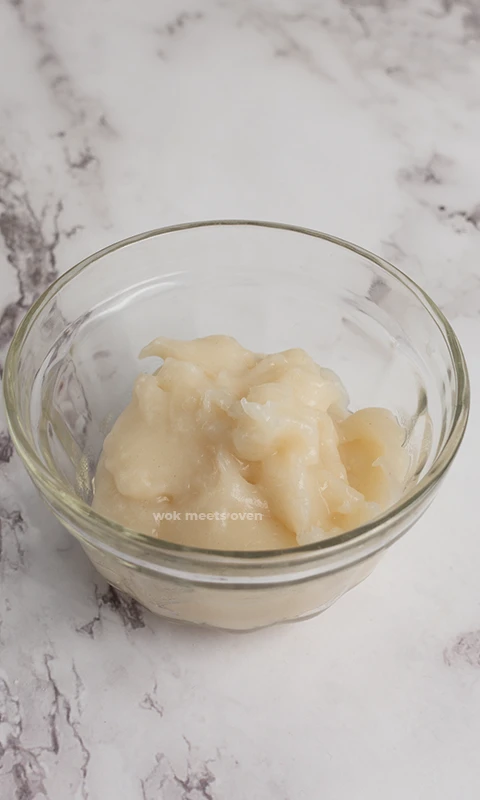
You can also make your Tangzhong the night before as well.
Dough
After our tangzhong has cooled down, we’re going to make our dough.
In a large mixing bowl, add in your bread flour, white granulated sugar, table salt, instant yeast, milk powder, 1 egg, and the tangzhong.
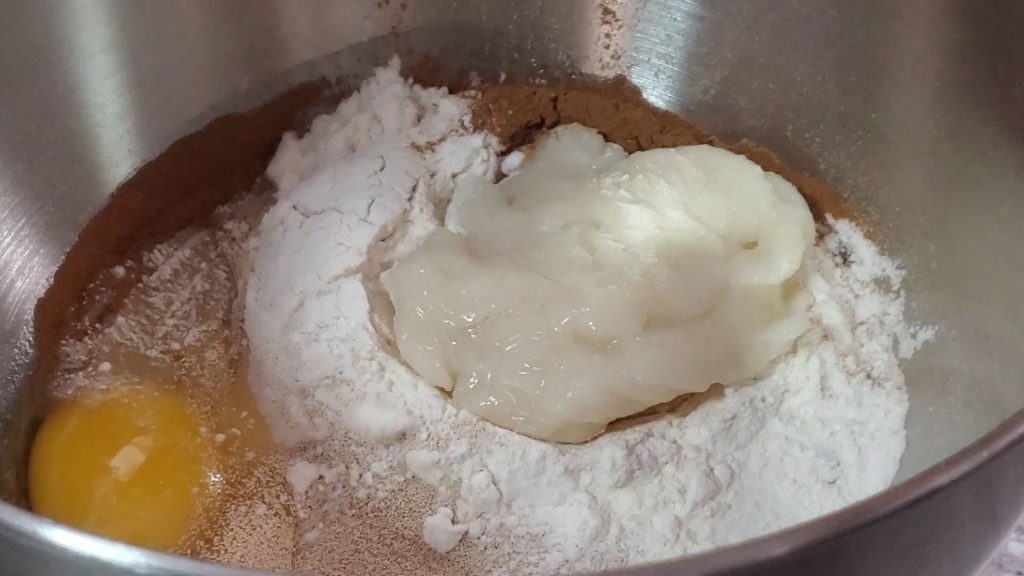
Pop the mixing bowl into a stand mixer and give it a quick few whisks.
Then add in your room temperature milk and mix everything together for 3-4 minutes.
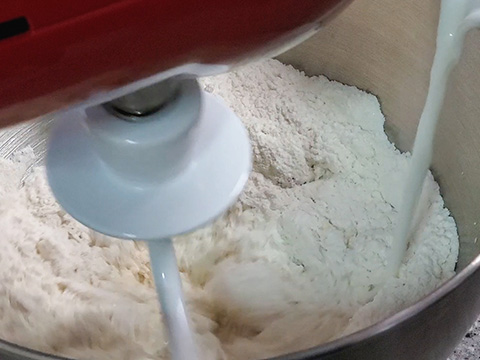
Then add in your room temperature butter and continue kneading the dough for an additional 11-12 minutes.
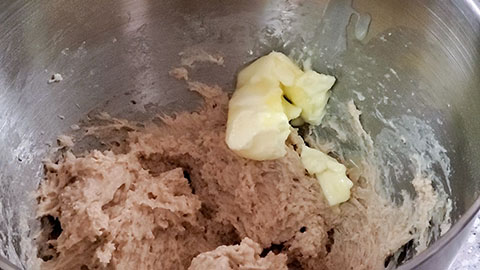
Next transfer the dough over to a greased large bowl.
Then shape the dough into a round ball. if you find the dough difficult to handle then you can apply either some oil or water to your hands.
Once done shaping the dough, place it back into the bowl and cover it with plastic wrap or a towel and let it proof in a warm place until double in size, approximately 1 hour.

Mexican Bun Topping
While the dough is proofing, we’re going to prepare our Mexican bun filling.
In a large bowl, add in your room temperature butter, white granulated sugar, and table salt.

Cream everything together then add in your egg to the mixture and mix everything well together.

Finally sift in your cake flour to the mixture and combine everything until you no longer see any white flour bits on the topping.


Next, put the Mexican topping inside of a piping bag along with a medium round piping tip and set it aside.


Dough Continued
Once our dough has finished proofing, de-gase the dough and transfer it to your countertop.


Shape it into a ball and weigh out the dough.
Next, divide the dough into 6 pieces and weigh out each piece.
Then shape each piece into a round ball.

Place each piece onto a baking tray lined with parchment paper and cover the dough with either plastic wrap or a towel.

Let the dough proof in a warm place for about 35-40 minutes.
Once the dough is done proofing it’s time to pipe the Mexican topping on top of the dough.
Pre-heat your oven to 350°F (180°C).
Take your piping bag filled with the Mexican topping and slowly start piping the Mexican topping onto each bun making a circular motion starting right in the middle of the bun and slowly expanding outwards, making sure to keep as close to each line as possible and keeping your wrist straight when piping down onto the buns.

You should be able to make 4-5 circles on each bun with the Mexican topping.
Try not to let there be any gaps when piping the Mexican bun topping, otherwise there will be small holes when you bake the buns in the oven.

Once you are finished piping the Mexican topping onto the buns, bake them in the oven at 350°F (180°C) for about 15-16 minutes and then remove them from the oven.


Tips
- Try to not leave any gaps between the Mexican topping when you are piping it on top of the buns otherwise there will be small cracks and holes when the buns are baked
- Try to keep your wrist straight when piping the Mexican topping otherwise the topping may end up slopping to the sides.
- If you find the Mexican topping hard to pipe, you can put it somewhere warm for about 5-10 minutes so that it becomes softer when piping.
Storage Tips
The buns can be left at room temperature in a sealed airtight container for up to 3 days or stored in the fridge for up to 7 days.
Frequently Asked Questions
Can I Use Dry Active Yeast Instead of Instant Yeast?
Yes, absolutely! If you’re using dry active yeast make sure that you proof the yeast in a warm liquid such as water or milk in our case along with some sugar (1 tsp). You should see the yeast foam up at the top and produce a very yeast like smell. If you see this, that means your yeast is good to use.
How Long Can I Store the Buns For?
You can store the buns in the fridge for up to 7 days or in the freezer for up to 3 months. Make sure that you reheat the buns either in a microwave or the oven if you stored them in the fridge or freezer to give them back their nice soft texture.
How Come My Dough Is Not Rising?
There could be a number of reasons such as the following:
- Your yeast is dead. Check if your yeast is still alive by adding 1 tsp of yeast, along with 1 tsp of sugar in 1/2 cup of warm water, give it a good mix, then let it sit for 10-15 minutes. If it starts to foam at the top with a very yeasty smell then your yeast is still alive.
- Your environment is too cold. Yeast rises best in a warm environment
- You mixed in hot water with the yeast and killed it.
- You didn’t knead the dough sufficiently enough. Use the window-pane test to check if your dough has been kneaded properly.
I Don’t Own a Stand Mixer, Can I Hand-Knead the Dough?
Yes, you can, however, do realize that the dough is sticky and will be more difficult to knead by hand, that is why it is strongly recommended that you use a stand mixer to make life easier for you. Furthermore, you may need to spend a little more time kneading it compared to using a stand mixer, however, it is definitely possible to hand knead it.
When is The Best Time to Eat These Buns?
Unlike other buns, I actually find the Mexican buns to taste better several hours later after they have been baked or even the very next day. That’s because the Mexican bun topping becomes softer the longer it has had time to sit and cool down. I have found that consuming the buns the next day produces a very soft crust that is simply irresistible and I often times end up wolfing down 2-3 buns in one go. Now because we’ve added in a tangzhong to the bread, the bread still remains soft the very next day and thus we don’t need to worry about the bread becoming stale. But if you like a more crispy crust on your buns then the best time to consume them would be several minutes after they have been baked.
Other Recipes You’ll Love
- Chinese Pineapple Buns (Bolo Bao) Recipe
- Chinese Coconut Cream Buns
- Chinese Cocktail Buns
- Chinese Hot Dog Buns
- Chinese Ham and Cheese Buns
You can pin this image

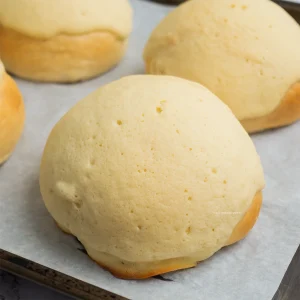
Hong Kong Mexican Bun
Equipment
- 1 stand mixer
Ingredients
Tangzhong
- 100 ml Water
- 20 g Bread flour
Dough
- 300 g Bread flour
- 95 ml 2% milk
- 1 Large Egg Room temperature
- 5 g Instant Yeast
- 20 g Unsalted butter Room temperature
- 40 g White granulated sugar
- 2 g Table salt
- 6 g Milk powder
Mexican bun topping
- 68 g Unsalted butter Room temperature
- 1/4 tsp Table salt
- 68 g Cake flour
- 40 g White granulated sugar
- 1/2 Large Egg Room temperature
Instructions
Tangzhong
- In a small saucepan, add your bread flour and water. Heat the pan on low heat while constantly stirring it until the mixture turns into a thick gelatinous paste.
- Then remove the pan from the stove and transfer it to a small bowl or dish. Cover it with plastic wrap and then store in the fridge and let it cool down for at least 30 minutes before using.
- You can also make your Tangzhong the night before as well.
Dough
- In a large mixing bowl, add in your bread flour, white granulated sugar, table salt, instant yeast, milk powder, 1 egg, and the tangzhong.
- Pop the mixing bowl into a stand mixer and give it a quick few whisks.
- Then add in your room temperature milk and mix everything together for 3-4 minutes.
- Then add in your room temperature butter and continue kneading the dough for an additional 11-12 minutes.
- Next transfer the dough over to a greased large bowl.
- Then shape the dough into a round ball. if you find the dough difficult to handle then you can apply either some oil or water to your hands.
- Once done shaping the dough, place it back into the bowl and cover it with plastic wrap or a towel and let it proof in a warm place until double in size, approximately 1 hour.
Mexican Bun Topping
- While the dough is proofing, we’re going to prepare our Mexican bun filling.
- In a large bowl, add in your room temperature butter, white granulated sugar, and table salt.
- Cream everything together then add in your egg to the mixture and mix everything well together.
- Finally sift in your cake flour to the mixture and combine everything until you no longer see any white flour bits on the topping.
- Next, put the Mexican topping inside of a piping bag along with a medium round piping tip and set it aside.
Dough Continued
- Once our dough has finished proofing, de-gase the dough and transfer it to your countertop.
- Shape it into a ball and weigh out the dough.
- Next, divide the dough into 6 pieces and weigh out each piece.
- Then shape each piece into a round ball.
- Place each piece onto a baking tray lined with parchment paper and cover the dough with either plastic wrap or a towel.
- Let the dough proof in a warm place for about 35-40 minutes.
- Once the dough is done proofing it’s time to pipe the Mexican topping on top of the dough.
- Pre-heat your oven to 350°F.
- Take your piping bag filled with the Mexican topping and slowly start piping the Mexican topping onto each bun making a circular motion starting right in the middle of the bun and slowly expanding outwards, making sure to keep as close to each line as possible and keeping your wrist straight when piping down onto the buns.
- You should be able to make 4-5 circles on each bun with the Mexican topping.
- Try to not let there be any gaps when piping the Mexican bun topping otherwise there will be small holes when you bake the buns in the oven.
- Once you are finished piping the Mexican topping onto the buns, bake them in the oven at 350°F (180°C) for about 15-16 minutes and then remove it from the oven.


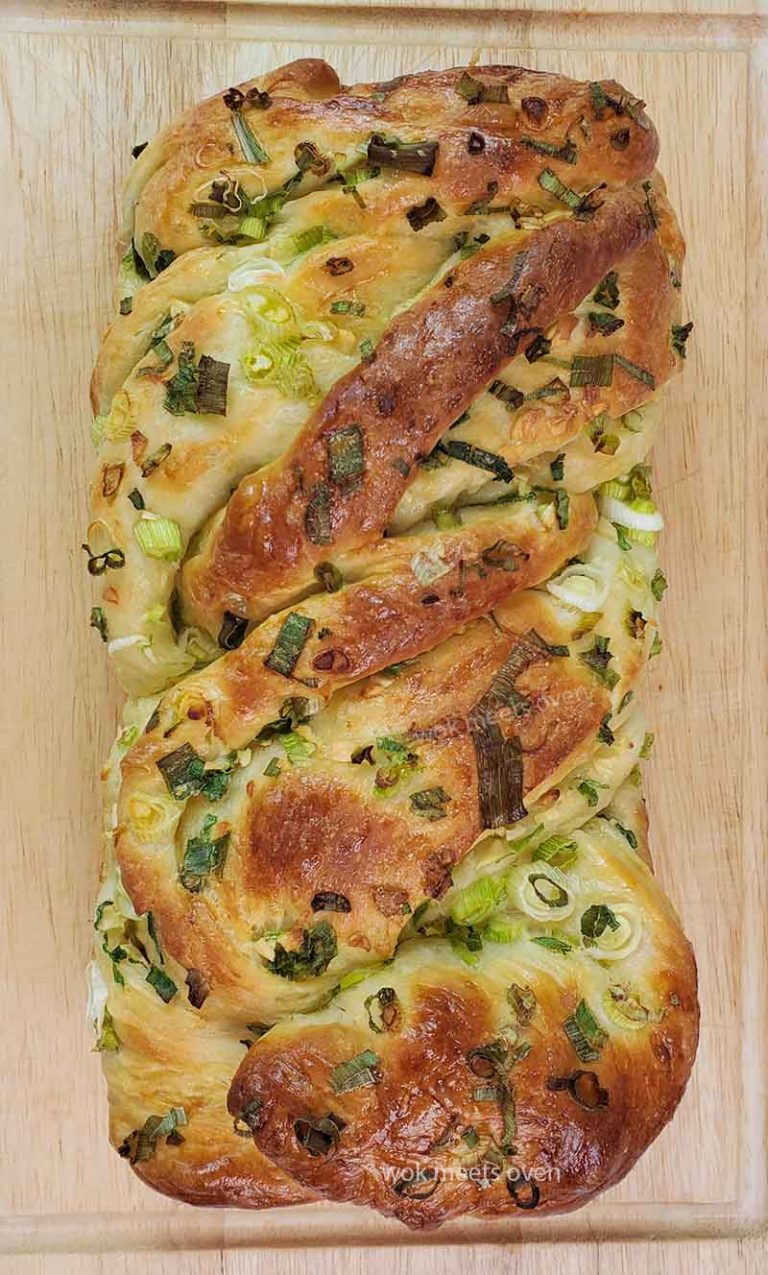
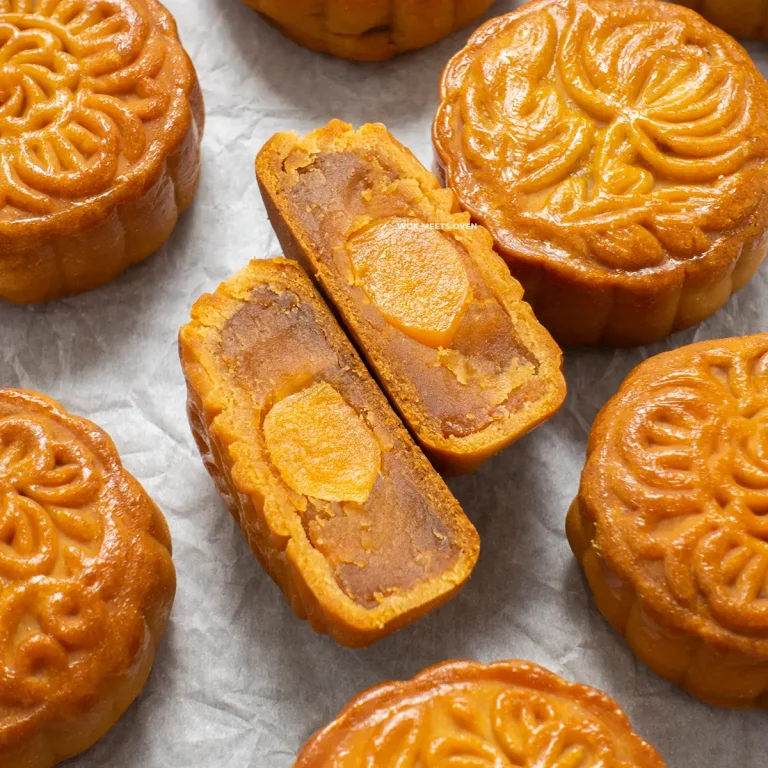
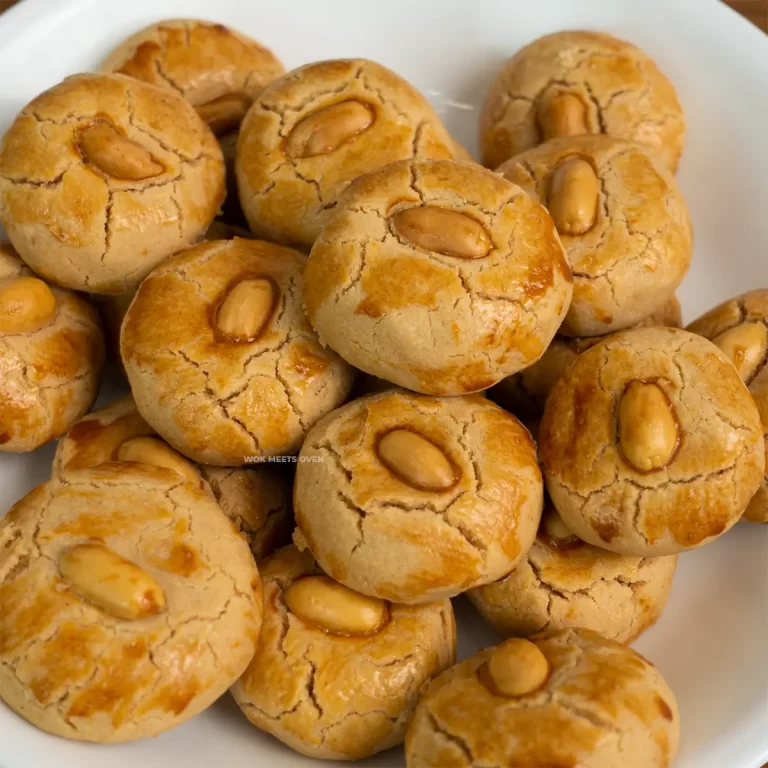
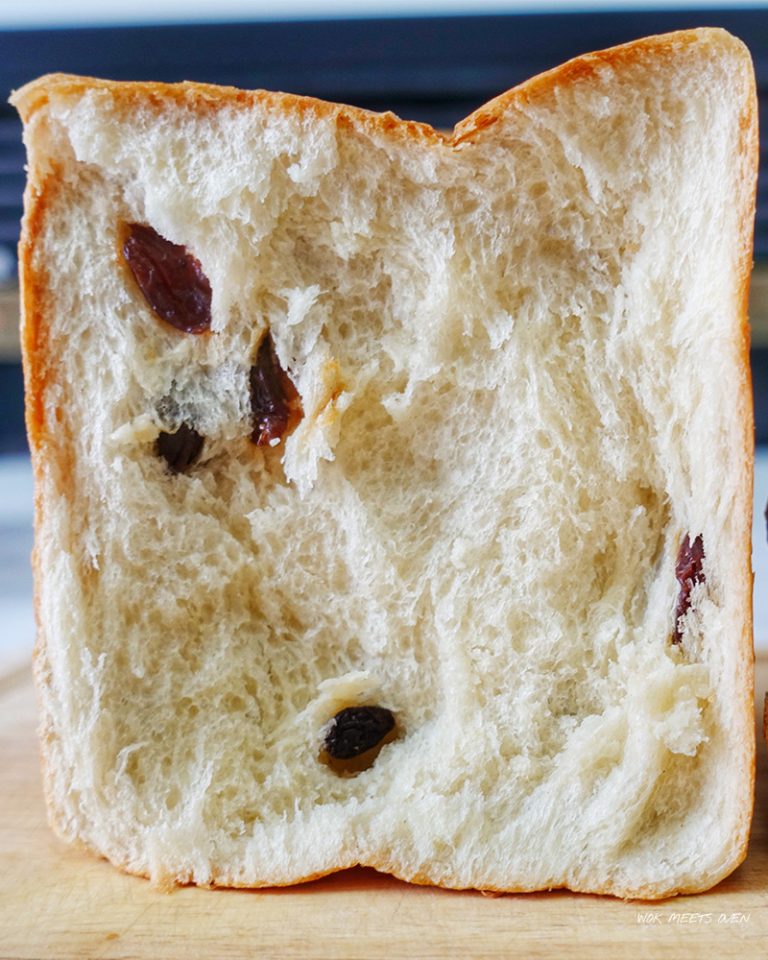

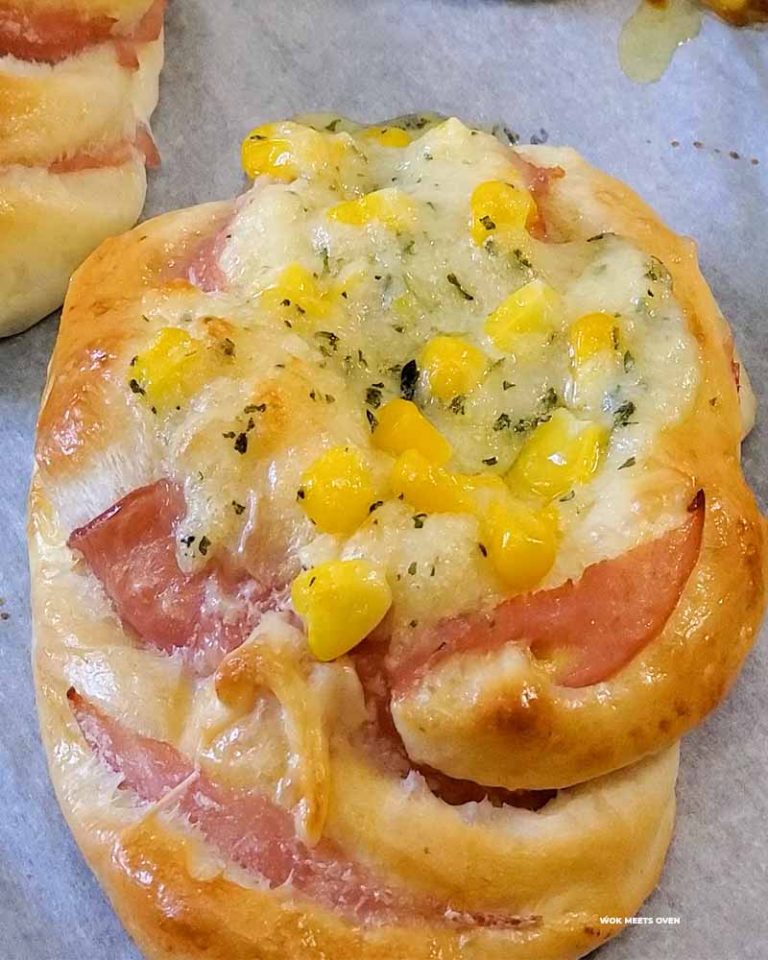
Hello, thanks for sharing your recipe! I can’t wait to try! I can’t find cake flour for the topping. Can I substitute for All Purpose flour? Thanks!
Hi Kelly!
Generally all-purpose has a higher protein content compared to cake flour which makes them a little stiffer when baked compared to cake flour. If you can find cake flour then I recommend you use that as it will produce a more softer texture. It sometimes will say pastry flour or cake & pastry flour when you’re shopping for cake flour but it’s the same thing. If you really cannot find cake flour then all-purpose will be fine, however do note that the texture will be a little different and possibly more stiffer.